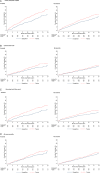Effect of dapagliflozin on anaemia in DAPA-HF
- PMID: 33615642
- PMCID: PMC11497230
- DOI: 10.1002/ejhf.2132
Effect of dapagliflozin on anaemia in DAPA-HF
Abstract
Aim: Anaemia is common in heart failure and associated with worse outcomes. We examined the effect of dapagliflozin on correction of anaemia in patients with heart failure (HF) and reduced ejection fraction in DAPA-HF. We also analysed the effect of dapagliflozin on outcomes, according to anaemia status at baseline.
Methods and results: Anaemia was defined at baseline as a haematocrit <39% in men and <36% in women. Resolution of anaemia was defined as two consecutive haematocrit measurements above these thresholds at any time during follow-up. The primary outcome was a composite of worsening HF (hospitalization or urgent visit requiring intravenous therapy) or cardiovascular death. Of the 4744 patients randomized in DAPA-HF, 4691 had a haematocrit available at baseline, of which 1032 were anaemic (22.0%). The rate of the primary outcome was higher in patients with anaemia (16.1 per 100 person-years) compared with those without (12.9 per 100 person-years). Anaemia was corrected in 62.2% of patients in the dapagliflozin group, compared with 41.1% of patients in the placebo group. The effect of dapagliflozin on the primary outcome was consistent in anaemic compared with non-anaemic patients [hazard ratio (HR) 0.68, 95% confidence interval (CI) 0.52-0.88 vs. HR 0.76, 95% CI 0.65-0.89; interaction P = 0.44]. Similar findings were observed for cardiovascular death, HF hospitalization, and all-cause mortality. Patients with resolution of anaemia had better outcomes than those in which anaemia persisted.
Conclusion: Patients with anaemia had worse outcomes in DAPA-HF. Dapagliflozin corrected anaemia more often than placebo and improved outcomes, irrespective of anaemia status at baseline.
Keywords: Anaemia; Clinical trials; Heart failure with reduced ejection fraction; Sodium-glucose co-transporter 2 inhibitor.
© 2021 The Authors. European Journal of Heart Failure published by John Wiley & Sons Ltd on behalf of European Society of Cardiology.
Figures


Comment in
-
Blood counts: targeting anaemia in patients with heart failure.Eur J Heart Fail. 2021 Apr;23(4):629-631. doi: 10.1002/ejhf.2173. Epub 2021 Apr 7. Eur J Heart Fail. 2021. PMID: 33779032 No abstract available.
References
-
- Silverberg DS, Wexler D, Blum M, Keren G, Sheps D, Leibovitch E, Brosh D, Laniado S, Schwartz D, Yachnin T, Shapira I, Gavish D, Baruch R, Koifman B, Kaplan C, Steinbruch S, Iaina A. The use of subcutaneous erythropoietin and intravenous iron for the treatment of the anaemia of severe, resistant congestive heart failure improves cardiac and renal function and functional cardiac class, and markedly reduces hospitalizations. J Am Coll Cardiol 2000;35:1737–1744. - PubMed
-
- Tang WH, Tong W, Jain A, Francis GS, Harris CM, Young JB. Evaluation and long‐term prognosis of new‐onset, transient, and persistent anaemia in ambulatory patients with chronic heart failure. J Am Coll Cardiol 2008;51:569–576. - PubMed
-
- Anand IS, Gupta P. Anaemia and iron deficiency in heart failure: current concepts and emerging therapies. Circulation 2018;138:80–98. - PubMed
-
- Pool PE, Braunwald E. Fundamental mechanisms in congestive heart failure. Am J Cardiol 1968;22:7–15. - PubMed
Publication types
MeSH terms
Substances
Grants and funding
LinkOut - more resources
Full Text Sources
Other Literature Sources
Medical
Research Materials
Miscellaneous

